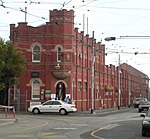Armadale railway station, Melbourne

Armadale railway station is located on the Frankston line in Victoria, Australia. It serves the south-eastern Melbourne suburb of Armadale, and it opened on 7 May 1879.The station, like the suburb itself, was named after Armadale House, the residence of former premier and attorney-general James Munro. The house was named after Armadale, Scotland, where Munro was born.The station was completely rebuilt when the line to Caulfield was re-graded in the early 20th century. The work included the quadruplication of the line, allowing stopping and express trains to run simultaneously.In 1978, a former goods siding and associated point work were booked out of use. A crossover was also removed around that time.
Excerpt from the Wikipedia article Armadale railway station, Melbourne (License: CC BY-SA 3.0, Authors, Images).Armadale railway station, Melbourne
Fetherston Street, Melbourne Armadale
Geographical coordinates (GPS) Address Website External links Nearby Places Show on map
Geographical coordinates (GPS)
| Latitude | Longitude |
|---|---|
| N -37.8563 ° | E 145.0193 ° |
Address
Platforms 2 & 3
Fetherston Street
3143 Melbourne, Armadale
Victoria, Australia
Open on Google Maps






